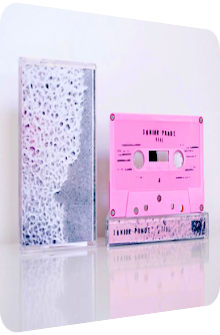
Junior Pande
Five
2015
Toronto-based drummer and synth aficionado Junior Pande aka Justin Peroff celebrates his fifth tape release at the rightful place, Joe McKay’s kaleidoscopic Spring Break Tapes label hailing from Los Angeles. Released in April 2015 in an edition of 100 cassettes, the pink sparkler is consequentially called Five and can be ordered directly from Spring Break Tapes. The title already showcases an interesting tendency aside from the obvious marker of this being the fifth release: it isn’t stylized or romanized. Imagine Peroff calling his tape V, and people in the know could have rightfully pondered a forceful shift into the Vaporwave genre, you know, that former cotyledon whose tentacles are both hailed as the savior and slated as the blight of a whole generation. Fact is that Junior Pande has embraced many of Vaporwave's traits in his previous tapes, and rest assured that some sparks approach the perihelia from time to time. However, Five remains a Hip-Hop album interpolated via synthetic positrons, jittery perianths and chromogenic drums; Peroff is the drummer of Broken Social Scene after all. And yet the tape's title remains a gentle understatement. Whereas previous releases such as The Red Tape (2014) made the listener aware of the fact that this isn’t just a red tape, but the red tape to cherish, Five doesn’t elbow itself to the forefront at first sight, but nonetheless encapsulates the artist’s primary prowess and achievement: filling cavernous ventricles with verglas estuaries… and coming up with one vignette after the other, ten per side, all within a duration of 17+ minutes. As a result, of course, the album flares up, gyring between ephemera and epitomes, caterpillars and cornerstones.
Side A opens with a clavicular fibroblast that fully embraces and wholly encapsulates the epistemology Junior Pande’s fans have accrued over the years. In aural terms, said knowledge translates into supra-sizzling hi-hat surfactants and a semi-granular translucency of tetragonal square lead melodies. This is old-school minimalism viewed through smudgy lenses, faintly pristine and yet rotoscoping around the playful kind of squalor. The second track succumbs to the same intrinsic scheme by revving up the lo-freq macula and augmenting this staggering chloroderivative with longitudinal bleeps, aqueous blips and short polyfoil bursts in the distance. While the third track comprises of tidal flexing, vaporwavy samples and an angular stop-and-go notion, the fourth installation is a mere beat-focused appendix sewn into the center before the fifth reticulation embraces a narcotic-purified three-note crystal loop which begs for a prolonged state, but finishes all too soon as well.
When the above five tracks have been played, 40% of side A have yet to materialize! This colloidal endeavor of diversity and fluidity resembles boon rather than bane for followers of Junior Pande, but there is the wish for slightly longer vignettes to cherish and absorb, a desire that remains unfulfilled in the physical, time-related sense, but is then targeted via textural puissance. Whether it is the industrial stokehold telomeres of track six, the gorgeously gelid upper midtempo ergosphere of track seven with its bone-dry clavichord splinters, sax fasciae and leeway freeway vocals, or track eight's maraca mamba mana that follows suit with its blistering shakers, honky tonk piano afterglows and jungular glitters, Justin Peroff’s fifth tape remains in a state of permanent diffeomorphism, adding more nematodes and sinews, supercharging its 17 minutes with ever more electropositive nuggets. One track deserves special praise, and that’s the outro of side A with its wondrously elasticized synth spherification, caustic crackles and beat-related railway set. A drowsy thiazide, a mellow mirage as the interim finale.
Side B meanwhile inherits all the stylistic expenses and salubrious dietary compositions that have been encountered before, but this doesn’t mean there aren’t surprises aplenty in store. Right from the get-go, the first track radiates the crimson kind of metallicity: blurry harbor-like steamer fuselages, snare punctilios that resemble the magnetotail of Jungle and a dusky atmosphere overall paint an ultramafic but ultimately crepuscular twilight fugacity. From this point onwards, however, comparative brightness keeps fueling the tape’s superresonance. Be it the scratchtastic vitalism amidst self-produced drum loops (track two), the thermal immersion circulator that superimposes the matutinal-viridian circumambience with pulsatile New Age erethism in multinucleate form (track four), the captivating synth choir-flavored p(i)anorama whose phototropism is driven by pyro-perturbations (track five), or the partially piercing pyroxene of aural aurum in tandem with rhombohedral syrinxes and agglutinated modular patches (track eight), side B bursts at the seams and leaves the decision to the listener whether to worship a sound-driven palinopsia or go all-in by embracing prosopagnosia.
Junior Pande’s Five offers the fluvio-lacustrine morphogenesis the fans rightfully expected, but Justin Peroff has taken his concept of short-lived vignettes made of long-lasting orthochromatic complexions to a new level whose nucleus isn’t concretely advertised by Spring Break Tapes head honcho Joe McKay as the very thing it really is: a vignettorama galore. The tracks are shorter than usual while the textural homeostasis thankfully remains zoetropic by nature. I am reminded of Sima Kim & Wouter Van Veldhoven’s tape Sketches (Umor Rex, 2014) which, as is plainly visible, freely reveals its state of flimsy fluxion and willfully degrades its diverse chemotaxis to a pulp affair. While this is not the necessary thing to carve out in terms of describing Junior Pande’s pink tape, the result can be quasi-unexpected even for diehard fans of the synthesist and drummer, as these shorties make the listener aware of the oxymoronic luxurious humility Peroff presents, addressing the time-related limits, volatile oxidants, violent flaring and floating macronutrients that reign within Five’s peritoneum. The question remains what the tape’s barycenter truly is: is it the shortness, the aliphatic connection between the single constituents, the textural wealth, the drums and patterns, the chirality – or was that chivalry – of Hip-Hop? That’s for Justin Peroff to know, for you to find out, and for the reviewer to fully grasp in a millennium or two.
Further listening and reading:
- Junior Pande’s Five is available from Spring Break Tapes.
- On the Twitters: @juniorpande @SBTAPES
Ambient Review 430: Junior Pande – Five (2015). Originally published on Apr. 29, 2015 at AmbientExotica.com.
